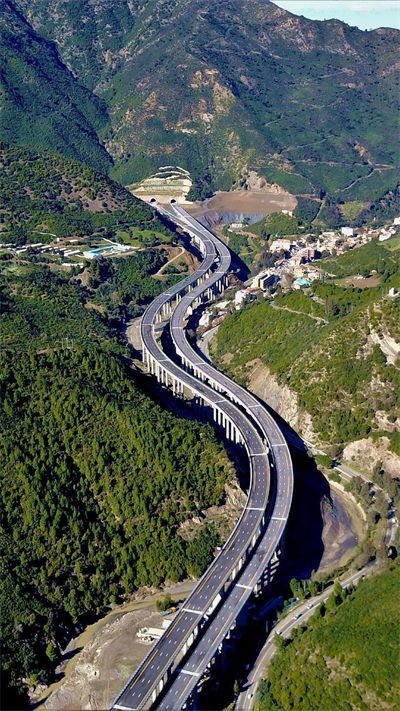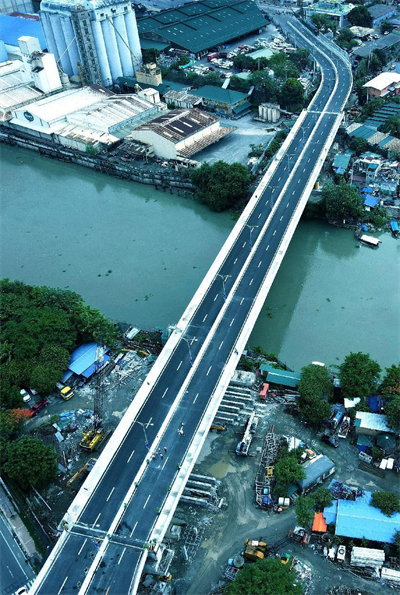China State Construction Engineering Corporation (CSCEC) continues to implement the Belt and Road Initiative and promotes infrastructure construction and cultural exchanges. It has built a number of bridges along the Belt and Road that drive local economic and social development, create employment opportunities and improve the ecological environment.

The construction project of bridges 1 to 5 in Hulhumalé, the Maldives, built by CSCEC International, is located at the junction of Phase 1 and Phase 2 of Hulhumalé Island. The bridge is the first channel in modern Maldives's history to connect the two most populous artificial islands. It is also the country's first single-span simply supported bridge project with prestressed post-tensioned cast-in-place hollow slab beams. The project efficiently connects the two reclaimed islands of Hulhumalé, which greatly facilitates local people's travel and serves as an integrated transportation and sightseeing facility, expanding the living space of Hulhumalé residents. It is affectionately known as "Bridge of Happiness and Connectivity" by local people.

The Indonesian Medan Airport Expressway Project, built by China Construction Fourth Engineering Division Corp. Ltd, is located in Medan, the capital of North Sumatra Province, Indonesia. With a total length of 17.8 kilometers, it includes four elevated interchanges, including the Kualanamu Interchange, eight mainline bridges, and one flyover. The project is an important part of the expressway network in northern Sumatra. It not only connects the city center of Medan with the new airport, but also greatly improves traffic in Medan and surrounding areas. It enhances the connection between North Sumatra and foreign countries, attracts more foreign tourists, and will promote the economic development of North Sumatra Province and its surrounding areas. During the construction process, CSCEC has established close cooperation with many local businesses, employed local staff members, and promoted local employment and the development of building materials and transportation industries.

The Algeria North-South Expressway project, jointly constructed by CSCEC Algeria and the China Construction Fifth Engineering Division, is 53 kilometers long and consists of 45 bridges. It serves as a vital transportation artery from the Mediterranean to the heart of Africa, running through the north-south direction of Algeria. Among them, the Algeria North-South Expressway V11.9 bridge, with a total length of 2.7 kilometers, is known as "the longest bridge in Algeria". The project has greatly shortened the travel time for vehicles to cross the Atlas Mountains, connected the north-south traffic arterial road in Algeria, and created the "Algeria North-South Economic Corridor" that is crucial for the development of Africa. Throughout the construction of the project, CSCEC has hired more than 10,000 local staff members, greatly boosting local employment. Through measures such as internships, observation and systematic training, the project cultivates local employees with technical expertise, imparts advanced construction experience, and contributes to the development of a large number of infrastructure talents in the country.

The Brunei Temburong Sea-Crossing Bridge, built by China Construction Sixth Engineering Bureau Corp., Ltd, is about 30 kilometers long and spans the Brunei Bay. It serves as a major sea-crossing gateway, connecting Muara District and Temburong District, and is the largest infrastructure project in Brunei. The CC4 section, constructed by China Construction Sixth Engineering Bureau Corp., Ltd, has a total length of 11.8 kilometers and is divided into upper and lower lanes, with a total of more than 1990 spans, all of which adopt prefabricated structures. The project has achieved a breakthrough of over eight million safe work hours, won the International Safety Excellence Award from the British Safety Council, and was selected as a typical case of foreign investment and cooperation by the Ministry of Commerce of China. The high-quality performance of the project has promoted cooperation and exchanges between the two countries and contributed to the development of Brunei's tourism industry.

The Dubai Shindagha Corniche Viaduct Project, undertaken by China State Construction Engineering Corporation (Middle East) (L.L.C.), includes a total of 24 continuous girder bridges in its main structure. Among them, three are cast-in-place continuous box girders, and 21 are prefabricated segmental assembly bridges, totaling 1,901 segments. It is one of the largest and most challenging projects in terms of construction difficulty in the Shindagha regional traffic corridor project group. The bridge erection of the project adopts "short-line segmental beam prefabrication and assembly" green construction technology, which has reduced the bridge construction period by more than 100 days. The new traffic corridor connects the new and old urban areas of Dubai, shortening the average commuting time in the Shindagha area from 110 minutes to 16 minutes. It greatly alleviates traffic congestion in the old urban areas of Dubai, improves the convenience of residents' travel, and supports the high-quality development of regional cities.

The Indonesia Manado-Bitung Expressway project, undertaken by China Construction Communication Engineering Group Corporation Limited, is an important road connecting the provincial capital and the tourist resort of North Sulawesi Province, Manado City, and the important port of Bitong. It is the first of six national strategic projects in the province to start construction. The Sungai Tongdano Bridge within the project is a critical control project for the entire Manado-Bitung Expressway, and it is also the first construction project to use high-pier sliding technology in Indonesia. It has won the Luban Award for overseas engineering. After the project opened to traffic, the travel time from Manado City to Bitong Port was shortened from the original two hours to 30 minutes, which eased transportation pressure and promoted local tourism and economic development. During the construction of the Sungai Tongdano Bridge, the project team also established close cooperation with local universities, providing internship opportunities and employment guidance for college students. They actively participated in earthquake relief and rescue work following the Palu earthquake and made multiple donations of daily necessities to affected areas.

The Philippine BGC-Ortigas Center Link Road Project, undertaken by China Construction Communication Engineering Group Corporation Limited, is a key project of the Filipino government to improve the country's traffic conditions. The Kalayaan Bridge spans a total length of 440 meters and was designed with two lanes in each direction. It crosses the Pasig River and is a main component of the BGC-Ortigas Center Link Road Project in the Philippines. The opening of the bridge has greatly eased traffic congestion in Manila, reducing travel time between Bonifacio Global City and Pasig City/ Mandaluyong City from one hour to just 12 minutes. It is of great significance to the Philippines in attracting foreign investment and promoting local economic development.
(Executive editor: Xie Yunxiao)